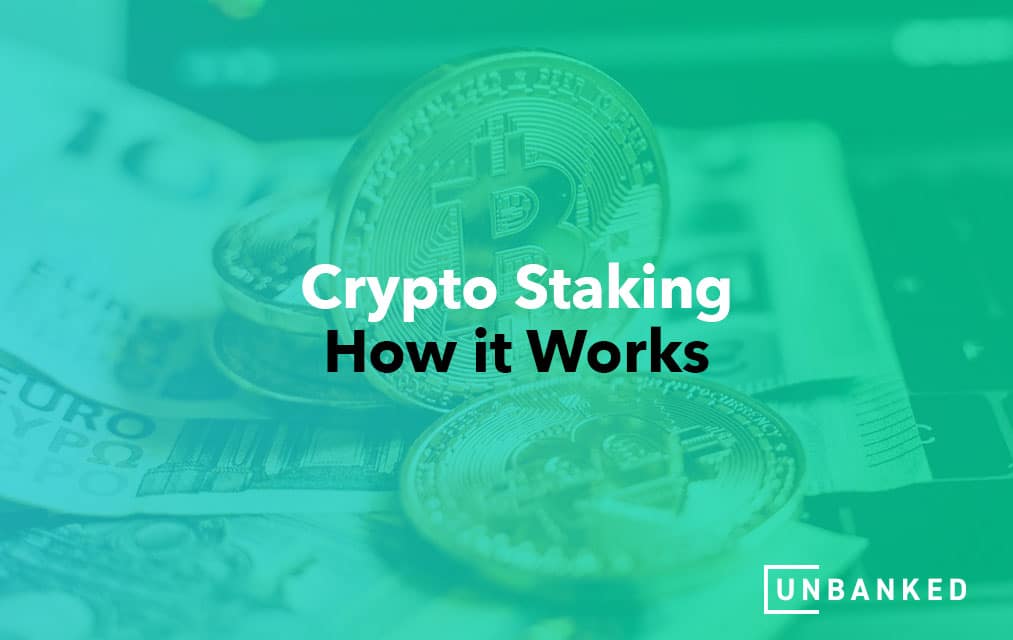Suppose you know anything about the ever-evolving world of cryptocurrency or virtual currency. In that case, you likely know that people typically make money by investing in and trading their cryptocurrency over time. However, there is another great way that you can start to grow your current crypto holdings without having to spend money on purchasing more. A specialized process known as “staking” can be a fantastic way to use certain types of cryptocurrencies to help verify transactions on blockchain networks. Investors who have utilized this technique have seen massive crypto yields that significantly exceed the typically amounts available through standard crypto savings accounts.
Please continue to find out exactly what the crypto staking strategy entails and what kind of benefits it could produce for your financial future within the cryptocurrency industry. Also, please consider exploring the range of quality services we offer here at unBanked, as well as our selection of expertly written educational articles covering everything you need to know about all things crypto!
Related: How to Sell Your Cryptocurrencies?
What is Crypto Staking, and How Does it Work?
To fully comprehend crypto staking, it helps to understand blockchain technologies and how they work. Blockchains are decentralized, distributed databases that allow users to collect “blocks” of recent transactions and submit them for inclusion into a historical record. Users whose blocks are accepted into the record are paid a transaction fee in the form of cryptocurrency. Crypto staking, in short, is a way of preventing fraud or errors within this process.
During staking, users proposing new blocks- or voting to accept a newly proposed block- can put some of their cryptocurrency on the line to incentivize everyone to play by the rules set forth on the blockchain. Generally speaking, the more crypto is at stake, the better a user’s chances of earning transaction fee rewards. The rewards for staking vary depending on the cryptocurrency used, the conditions or demand on the blockchain, and the staking method used. However, those considering this practice should keep in mind that if the proposed block contains inaccurate information, they can lose some of their staked cryptos in a process known as slashing.
Related: Why You Should Invest in Crypto Wallets You Trust

How do You Stake Cryptocurrency?
There are multiple ways that people can start staking their crypto, depending on how much of a financial, technical, and research commitment they are willing to make. The first step of the process involves deciding whether they will be validating transactions themselves with their computer or delegating the validations to someone else who will take care of the legwork. Delegating the process means less work. However, it also means that the other users will earn a share of the rewards.
From there, there are five easy steps to follow to start your crypto staking venture. These include;
- Step 1: Choose your cryptocurrency to stake and a specific exchange to stake on (explore the list in the next section to find the best choice for you).
- Step 2: Research and learn the minimum staking requirements involved with your chosen crypto.
- Step 3: Download and create an account with the specific software wallet needed for your chosen crypto.
- Step 4: Figure out the best hardware to use and ensure you have access to a constant, uninterrupted internet connection.
- Step 5: Begin your crypto staking adventure!
If you’d rather not trust an exchange to make your staking decisions for you, you also have the option to join an already established staking pool that another user operates.
Are you ready to take better control over your financial future through the power of cryptocurrency, crypto-investing, and crypto staking? Learn about how you can effectively take the crypto world by storm with the help of our trusted experts here at unBanked today.
Which Cryptocurrencies and Exchanges Allow Crypto Staking?
If you want to get involved in the process of staking cryptocurrency, you’ll have to ensure you’re working with specific crypto and exchanges that permit the practice since not all of them do. Thankfully, there are numerous platforms and types of crypto that you can access that make the staking process relatively quick and easy.
Popular Crypto Staking Exchanges:
- Coinbase
- Kraken
- Binance.US
- eToro
Popular Cryptocurrencies Used for Staking:
What Kind of Returns Does Crypto Staking Offer?
As stated previously, the rewards for staking your crypto depend on a range of different factors, such as the crypto you use, the demands on the blockchain network, and more. That said, the rates typically offered by the exchanges that allow crypto staking can give you a relatively decent insight into the kind of returns you can expect to see from your efforts. For example, a report on the Binance.US exchange from 2021 suggested that the annual rewards for staking Algo typically ranged between 8%-10%. While returns for staking Algo on Coinbase typically yielded a 4% yearly yield. Meanwhile, ETH delivered a 4.5% annual yield on Coinbase.
Related: Why You May Prefer Stablecoins Over Regular Cryptocurrency
Is staking crypto taxable?
That’s a question that’s been on the minds of many crypto enthusiasts, and rightfully so. Cryptocurrency staking has become increasingly popular in recent years, as it offers investors a way to passively generate income without having to manage their own portfolios. However, with any form of passive income comes the questioning of taxes – and crypto staking is no exception.
Fortunately, there is some good news: most countries take a “hands-off” approach when it comes to taxing crypto staking rewards. This means that you won’t be taxed for the rewards you receive from staking your coins – but there are some caveats. The exact rules vary from country to country.
What are the pros and cons of staking?
Staking crypto is a great way to maximize returns while minimizing risk. It also gives investors the ability to take advantage of price fluctuations without having to manage their own portfolios. While it’s not necessary to actively monitor your coins (as with active trading), there are some downsides that need to be taken into consideration before deciding whether or not it’s the right move for you.
One potential downside is that staking usually requires a minimum amount of coins – usually at least around 1000-2000. This can be an obstacle for newer investors who may not have that much capital available. Additionally, rewards from staking tend to be relatively low compared to other forms of passive income, such as interest from savings accounts or dividends from stocks.
Finally, there are also other risks associated with staking such as the possibility of being “slashed” if you make a mistake or don’t follow the rules of the network. Slashing is when a portion of your coins are taken away as punishment for not following protocol. Therefore, it’s important to understand all the risks before investing in crypto staking.
Ultimately, crypto staking can be an attractive option for investors who want to take advantage of price movements without managing their own portfolios. However, it’s important to note that there are some potential downsides and risks associated with this type of investment – so do your research and make sure you understand exactly what you’re getting into before you commit.
Related: WHAT IS FINTECH? THE FINTECH INDUSTRY EXPLAINED
Is staking safer than trading?
That depends on your risk tolerance and the amount of capital you have available. Crypto trading is often more volatile than staking, so if you’re looking for a way to maximize returns without taking on too much risk, then staking may be the better option.
Make sure to note that both options come with their own potential risks and rewards – so do your research and make sure you understand exactly what you’re getting into before committing to either.
Is staking better than holding?
Again, that depends on your risk tolerance and the amount of capital you have available.
Staking offers a way to passively generate income without having to manage your own portfolio, which makes it attractive for some investors.
However, rewards from staking tend to be relatively low compared to other forms of passive income such as interest from savings accounts or dividends from stocks. Therefore, it’s important to consider all potential risks and rewards before making any decisions regarding your investments.

How often do you get paid when staking?
It depends on the network you’re staking on. Some networks pay out rewards every day, while others may only pay out once a month or even less frequently.
Additionally, some staking pools allow you to withdraw your earnings whenever you want, while others require that you wait for a certain period of time before withdrawing. Be sure to read all the details about the network and any terms of service associated with it before investing in crypto staking.
What are some good strategies for taking advantage of crypto staking?
The most important thing is to do your research and understand exactly how the process works before committing any capital. You should also look into different types of staking such as delegation, solo mining and pool mining to determine which is best for your goals. It’s important to consider the rewards you’re likely to receive for various types of staking and assess any associated risks. Finally, make sure that you only stake coins on reputable networks with solid track records.
Related: TAXES ON CRYPTO: BEST GUIDE FOR 2023
What happens when staking ends?
When staking ends, you will receive your rewards minus any associated fees. Depending on the network and type of staking, these rewards may be in the form of a fixed amount or a percentage of the total coins held.
Be sure to read all terms and conditions associated with any staking pool or network before investing so that you understand exactly what happens when it ends. Make sure that you withdraw your funds as soon as possible after staking ends to avoid any potential risks from leaving them in a wallet or exchange.
Final Thoughts and Considerations to Keep in Mind Going Forward
Now that you have a more comprehensive understanding of the crypto staking process and what it can do to help bolster your crypto earnings, you can feel free to try the practice out for yourself! For even more technical information on navigating successfully within the wonderful cryptocurrency world, please don’t hesitate to explore the wide range of expertly written educational articles provided by our trusted professionals at unBanked today. Also, don’t forget to explore our range of specialized crypto banking services, which can give you a fast, easy, and effective way to buy, sell, and send crypto while earning you massive rewards in the process.
Are you searching for ways to educate yourself on and effectively utilize your hard-earned cryptocurrency so you can start building the groundwork for a better financial future? Consider exploring the range of quality products, services, and educational articles proudly provided by our experts here at unBanked today to learn more.





